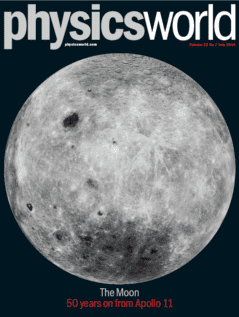When NASA’s Apollo 11 craft landed on the Moon 50 years ago on Sunday 20 July 1969 at 20:18 (UTC), it was not just a significant moment in the history of science and technology. Those famous footsteps – first by Neil Armstrong and then Buzz Aldrin – were also witnessed by millions of “ordinary” people around the Earth.
It can be hard to comprehend how people set foot on the Moon with technology far inferior to today’s, especially as it’s only now, five decades later, that we’re thinking of sending astronauts back to the Moon again. But when that does happen, the insights from the Apollo programme will be crucial – after all, the 12 Apollo astronauts who walked on the Moon between 1969 and 1972 did more than just nose around.

As writer and broadcaster Sue Nelson explains in the July 2019 special issue of Physics World, science was at the forefront of the Apollo missions, with their astronauts performing more than 50 experiments on the lunar surface and collecting around 382 kg of Moon-rock samples. Indeed, one experiment, the lunar ranging retroreflectors, is still running today, as Robert P Crease explains.
Elsewhere in the issue, Beijing-based science writer Ling Xin reveals the inside story of China’s Chang’e 4 craft, which is the first lander to explore the far side of the Moon (an image of which is depicted on the new issue’s cover).
Finally, in a wonderful feature for which we’ve created a short, fun video (see above), astrophysicist Ethan Siegel reminds us just why our Moon is so important to us, by imagining a world in which our Earth had no Moon at all. It’s all pure speculation of course, but as well as darker skies and much smaller tides, would we have even stepped foot on another planet? You can read the feature online here too.
You can enjoy the entire July 2019 issue of Physics World magazine via our digital apps for iOS, Android and Web browsers (membership of the Institute of Physics required). Let us know what you think about the issue on Twitter, Facebook or by e-mailing us at pwld@ioppublishing.org.
For the record, here’s a run-down of what’s in the issue.
• A string of upcoming lunar missions will yield many scientific breakthroughs, as James Dacey discovers.
• Money from the Moon – James McKenzie reflects on the possible business opportunities from future missions to the Moon and beyond
• Defending the lunar landscape – John Budden calls for certain areas on the Moon to be protected from human interference so that they can be dedicated to radio astronomy

What’s in a moon?
• Giant leaps for knowledge – NASA’s Apollo 11 mission will forever be remembered as the first to land humans on the Moon. But the mission and the rest of the Apollo programme should also be remembered for the science it achieved and enabled. Sue Nelson explores Apollo’s scientific legacy
• What’s in a Moon? –What would life on our planet be like if the Moon were to vanish; or perhaps if we had multiple moons? Earth wouldn’t be the same without its constant lunar companion, as Ethan Siegel explains
• How high the Moon – Half a century after the historic Apollo 11 landing on 20 July 1969, Robert P Crease explains why the mission’s lunar laser ranging experiment is alive and well – and still encountering new frontiers
• Exploring the far side – The far side of the Moon remained an untouched territory until a Chinese lander, called Chang’e-4, touched down in the region earlier this year. Ling Xin examines the consequences for our understanding of Earth’s nearest neighbour
• Intergalactic explorers’ handbook – Tushna Commissariat reviews The Space Race: the Journey to the Moon and Beyond by Sarah Cruddas
• Race to lunar space – Andrew Glester reviews Apollo 11: the Inside Story by David Whitehouse
• A new look at our old Moon – Sarah Cruddas reviews The Moon: a History for our Future by Oliver Morton
• Diamonds are a physicist’s best friend – Julianna Photopoulos talks to Pascal Gallo, co-founder and chief executive of Swiss start-up company LakeDiamond, about his career in quantum physics and crystal growth
• Once a physicist – meet Louise Adams, an IT transformation expert at PA Consulting
• Microbes and the Moon – Michael Hill-King on why we quarantined the Apollo 11 astronauts.



